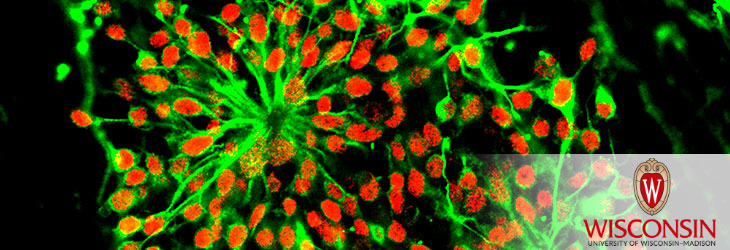Pluripotent Stem Cells

Improved Method for Generating Epicardium from Human Pluripotent Stem Cells
WARF: P150192US02
Inventors: Sean Palecek, Xiaoping Bao, Xiaojun Lian
The Wisconsin Alumni Research Foundation (WARF) is seeking commercial partners interested in developing a xeno-free platform for generating high purity epicardial cells from hPSCs at greater yield and lower cost than existing methods.
This fully defined, albumin-free differentiation protocol efficiently derives self-renewing epicardial cell lineages from hPSCs, and may provide insights into mechanisms of heart development, maturation and response to cardiac injury.
Overview
Given their developmental importance and therapeutic potential, epicardial cells and epicardium-derived cells are a promising progenitor source to restore functional vasculature, maintain cardiomyocyte survival and repair damaged heart tissue. Accordingly, there is a need for efficient and cost-effective protocols for generating functional epicardial cells under chemically defined culture conditions and in the absence of certain growth factors previously thought to be an essential part of directed epicardial differentiation.
The Invention
UW–Madison researchers have developed a xenogeneic- and albumin-free protocol targeting key regulatory elements of the Wnt/β-catenin signaling pathway, thus simplifying the steps and components for deriving cardiomyocyte progenitors and epicardial cells from hPSCs.
The innovation is based in part on the researchers’ discovery that differentiation stage-specific modulation of canonical Wnt signaling is sufficient for efficient epicardial induction from hPSCs under chemically defined, albumin-free conditions. Activation of Wnt signaling induces mesodermal differentiation, while subsequent Wnt inhibition drives cardiac specification. Reactivation of Wnt in cardiac progenitors specifies epicardial cells. These cells retain many characteristics of primary epicardial cells, including formation of a polarized epithelial sheet, expression of key epicardial genes, Wilms' tumor suppressor protein 1 (WT1), TCF21, TBX18 and ALDH1A2, and the ability to undergo epithelial-to-mesenchymal transition to generate fibroblast and vascular smooth muscle lineages.
Advantageously, inhibition of TGFβ pathway signaling via culture in the presence of small molecules permits long-term maintenance of hPSC-derived epicardial cells in vitro.
The innovation is based in part on the researchers’ discovery that differentiation stage-specific modulation of canonical Wnt signaling is sufficient for efficient epicardial induction from hPSCs under chemically defined, albumin-free conditions. Activation of Wnt signaling induces mesodermal differentiation, while subsequent Wnt inhibition drives cardiac specification. Reactivation of Wnt in cardiac progenitors specifies epicardial cells. These cells retain many characteristics of primary epicardial cells, including formation of a polarized epithelial sheet, expression of key epicardial genes, Wilms' tumor suppressor protein 1 (WT1), TCF21, TBX18 and ALDH1A2, and the ability to undergo epithelial-to-mesenchymal transition to generate fibroblast and vascular smooth muscle lineages.
Advantageously, inhibition of TGFβ pathway signaling via culture in the presence of small molecules permits long-term maintenance of hPSC-derived epicardial cells in vitro.
Applications
- Generation and long-term maintenance of hPSC-derived epicardial cell populations
- Regenerative therapies and other clinical uses
- Research
Key Benefits
- Inexpensive and reproducible
- Chemically defined
- Free of xenogeneic components
- Generates cells suitable for translational applications
Stage of Development
The researchers’ findings support a model of human epicardial development in which small molecule-mediated exogenous modulation of Wnt/β-catenin signaling is sufficient for the specification of epicardial cells from hPSCs. Moreover, they have shown that hPSC-derived epicardial cells can invade the myocardium in an infarcted mouse model, suggesting potential applications in cell-based heart regeneration.
Additional Information
For More Information About the Inventors
Related Technologies
Publications
- Bao X., Lian X., Qian T., Bhute V.J., Han T. and Palecek S.P. 2017. Directed Differentiation And Long-Term Maintenance Of Epicardial Cells Derived from Human Pluripotent Stem Cells Under Fully Defined Conditions. Nature Protocols, 12(9), 1890-1900.
Tech Fields
For current licensing status, please contact Andy DeTienne at [javascript protected email address] or 608-960-9857